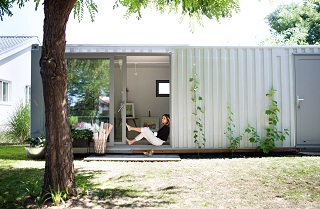As you embark on building your dream home from a shipping container, it’s crucial to understand the financial implications. Shipping container homes, lauded for their affordability and sustainability, have gained immense popularity. However, the true costs involved can be complex and varied. This article aims to provide a comprehensive guide to budgeting for your shipping container home, ensuring that your dream does not become a financial nightmare.
Understanding The Basics Of Shipping Container Homes
Before diving into the financial aspects, let’s briefly overview what a shipping container home is. These structures are built using repurposed shipping containers, which are robust, modular, and relatively inexpensive. The flexibility and durability of these containers make them an excellent choice for innovative housing.
Budgeting For Purchase And Delivery
The first financial consideration is the purchase and delivery of the shipping container itself. Prices vary based on size, condition, and location. A standard 20-foot container might cost you anywhere between USD$1,500 to USD$3,000, while a 40-foot high-cube container could set you back USD$4,500 or more. Delivery costs depend on the distance from the supplier. A reputable supplier like Royal Wolf can provide quality containers and delivery services, but remember to include these costs in your initial budget.
Site Preparation And Foundation Costs
After securing your container, preparing the site is the next step. Site preparation involves clearing the land, leveling, and laying a foundation. The foundation is crucial for the structural integrity of your home. Depending on the complexity, this phase can cost anywhere from USD$5,000 to USD$15,000.
Design And Planning Expenses
Designing your container home is not just about aesthetics; it’s about creating a functional, safe, and efficient living space. The costs involved in this phase cover architectural design, interior layout, and ensuring structural integrity. An architect or designer with experience in container homes is crucial because they understand such structures’ unique challenges and potential. These professionals can help you optimize space, choose the right materials, and ensure your vision complies with building codes. The fees for these services typically represent 5% to 15% of your total budget, depending on the design’s complexity and the designer’s or architect’s reputation.
Permits And Legal Fees
Securing the necessary permits is a step you can’t afford to overlook. The cost and requirements for permits vary greatly depending on your location, the size and complexity of your project, and local zoning laws. These permits ensure your home meets building codes, safety standards, and zoning regulations. Legal fees might also incur if you need to consult a lawyer for property-related issues or to navigate complex zoning laws. These expenses can range from a few hundred to several thousand dollars, so it’s essential to research and budget for them accordingly.
Structural Modifications And Reinforcement
Shipping containers are built to be sturdy and withstand harsh conditions, but turning them into a habitable space requires significant modifications. Cutting out sections for windows and doors or creating an open floor plan compromises the container’s structural integrity. Reinforcements, such as steel beams or additional framing, are necessary to ensure safety and stability. These structural changes must comply with building codes and often require professional engineering services. Depending on the extent of the modifications, allocate 10% to 20% of your total budget to this category.
Insulation And Climate Control
Insulation is a critical aspect of making your container home livable and energy-efficient. The right insulation keeps your home warm in winter and cool in summer, reducing energy costs. The type of insulation you choose (spray foam, panel, or blanket) will depend on your climate and budget. In colder climates, high-quality insulation is paramount to prevent heat loss. Similarly, insulation coupled with efficient ventilation systems is crucial in hotter regions. Budgeting around USD$1,500 to USD$5,000 for insulation and climate control systems is a safe estimate. Still, prices can vary based on materials and labor costs.

Interior Finishing And Utilities
Interior finishing includes everything from flooring and painting to kitchen and bathroom installations. The range of finishing options is vast, and the costs can vary significantly. Basic finishes like laminate flooring, standard fixtures, and basic appliances are more affordable. In contrast, luxury finishes like hardwood floors, high-end appliances, and custom cabinetry will increase the budget. Additionally, installing essential utilities like water, electricity, and sewage systems involves the cost of materials and professional installation. These expenses can be substantial, especially if your site is not connected to local utilities. Allocating 20% to 30% of your overall budget for interior finishing and utilities is advisable.
Exterior Additions And Landscaping
The exterior of your container home is as important as the interior. Options for exterior enhancements include decks, patios, exterior cladding, and painting. Landscaping can transform the outdoor space, adding aesthetic and functional value to your home. Simple landscaping might involve lawn seeding, basic garden beds, or a few trees. At the same time, more elaborate designs might include terraced gardens, outdoor kitchens, or water features. The costs for these additions vary greatly, but investing in the exterior can significantly enhance your home’s curb appeal and overall value.
Maintenance And Upkeep Costs
While shipping container homes are known for their durability and low maintenance requirements, some upkeep is necessary. This includes routine checks for rust and corrosion, particularly in harsh climates, repainting, and general repairs. Regular maintenance ensures the longevity of your home and prevents minor issues from becoming major expenses. Budgeting for these ongoing costs is crucial for the long-term sustainability of your container home.
Conclusion
Building a shipping container home can be a rewarding and cost-effective way to create your dream residence. By carefully planning and budgeting for each aspect of the construction, you can ensure a smooth process and avoid unwelcome financial surprises. Remember, thorough research and detailed planning are your best tools in this exciting endeavor.

